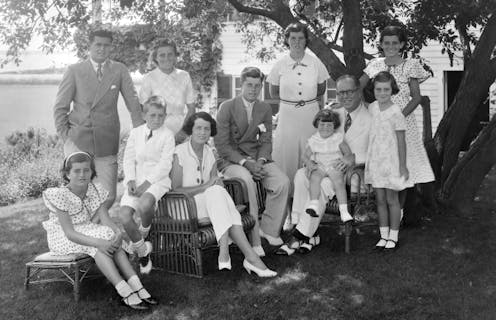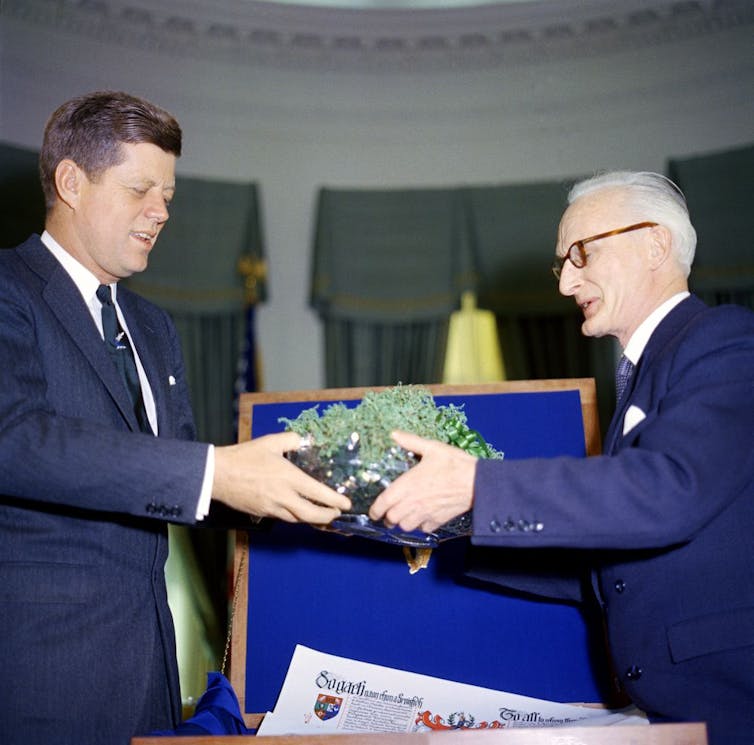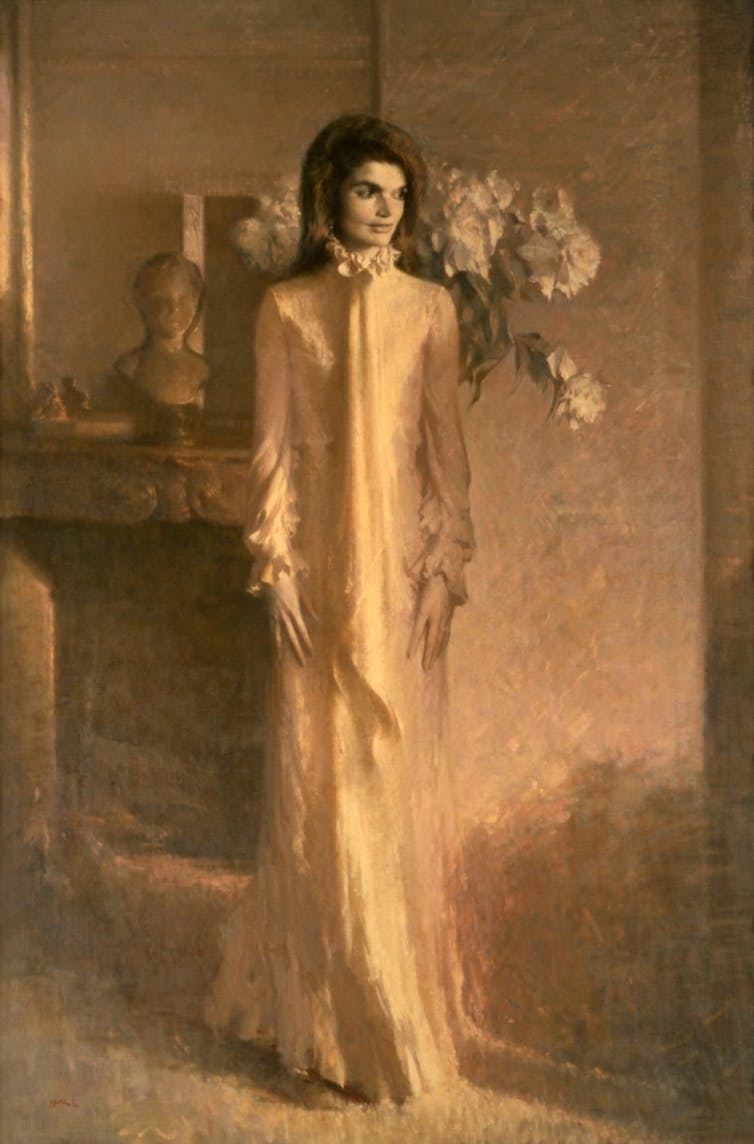The luck of the Irish might surface on St. Patrick's Day, but it evades the Kennedy family, America'
Gothic storytelling, with its sinister atmosphere of conspiracy and other hallmarks, offers a way to reframe the Kennedy family lore.

John F. Kennedy, whose ancestors left Ireland during the potato famine of the mid-19th century, was famously the first United States president of Catholic Irish descent.
When Americans narrowly elected Kennedy in 1960, anti-Catholic bias was still part of the mainstream culture.
I am a scholar of Irish literature and the author of “Race, Politics, and Irish America: A Gothic History,” a new book that describes how the Irish were long excluded in America.
So when Kennedy accepted shamrocks from the Irish ambassador to the U.S. on his first St. Patrick’s Day in the White House in 1961, it signaled the social and political arrival of the Irish American elite. It also was a pivotal moment, marking Irish Americans’ fulfilled dream of full assimilation into the U.S.
The dream soured when Kennedy was assassinated in Dallas in November 1963. That tragedy – and the many others that followed for the Kennedy family – began to be told by others in the Gothic story tradition, which hinges on nightmarish scenarios and the abuse of power.
This kind of storytelling has shown to be a suitable match for the different narratives of the Kennedys as both innocent victims and wicked schemers.
The phrase “the luck of the Irish” is often used of Irish America, especially on St. Patrick’s Day, observed on March 17. Since it typically refers to good luck, however, it cannot be used of Irish America’s best-known dynasty.
This phrase has various proposed origins, including the success Irish gold miners had in the U.S. in the 1800s.
Irish America’s best-known dynasty might not be described as lucky, but rather as Gothic.

The Kennedys and Gothic
Since its 18th-century beginnings in literature, Gothic storytelling uses a sinister atmosphere of conspiracy and the supernatural. It also generally features an all-powerful Catholic patriarch.
Many other elements repeat over centuries in different classic Gothic works, like “Dracula,” for example. This can include a secret or curse linked to a corrupt bloodline, endangered beautiful women and disrupted inheritance or murdered heirs.
For both sides of America’s political divide, the Kennedys fit the ready-made mold of Gothic, though in different ways.
After JFK’s assassination, liberals and Democrats who had approved of his administration’s progressive policies believed that the idealistic Kennedys were the blameless targets of dark conspiracies.
These conspiracies included persistent questions about who or what was behind JFK’s assassination, even though a former Marine, Lee Harvey Oswald, was arrested in 1963 and charged in the president’s death. Oswald himself was killed before he could stand trial, feeding the conspiracy theories.
However, for conservatives and Catholic Irish Americans leaving traditional Democratic Party loyalty behind, the family known as “America’s royals” represented the corruption of the elite.

The Gothic patriarch, Joe Kennedy Sr.
In traditional Gothic fiction, the usual source of such immorality is the all-powerful Catholic elder.
In the Kennedy narrative, that role of Catholic elder is played by the president’s father, Joe Kennedy Sr. He was a wealthy investor and politician. Kennedy family biographers have recorded rumors of shady dealings in his numerous business interests.
In addition, the Kennedy patriarch’s very Gothic ambitions to hereditary rule were repeatedly disrupted.
Joe Sr. strategized to help launch JFK’s political rise only after the first-born he had planned to make president, Joseph Jr., was shot down and killed in action during World War II.
Jackie Kennedy
The Kennedy Gothic narrative also enfolds people who marry into the family.
Joe Sr.‘s daughter-in-law, Jacqueline Kennedy, was filmed clambering over the back of the presidential open-top limousine in a bloodied suit immediately after her husband was shot while being driven in a motorcade. In that moment, she became Gothic’s classic endangered, beautiful woman.
Strikingly, Jackie Kennedy’s eerie official portrait resembles the fleeing woman in a flowing white gown of Gothic paperback cover tradition.
Right after her husband’s assassination, Jackie Kennedy talked about how the Dallas mayor’s wife had given her blood-red roses earlier that day – which she implied was a bad omen of the forthcoming assassination, given the flowers’ color.
In the same interview, Jacqueline used the phrase “Camelot” to refer to the idealism of her husband’s administration.
However, many biographies and media stories in the years that followed painted the picture of a morally complex Kennedy family.

The Kennedy curse
Some Kennedy men’s sexually promiscuous or otherwise “liberal” behavior with women, for example, got as much press as their liberal politics.
In 1969, a year after Robert Kennedy was assassinated during his presidential run, his brother Ted drove off a bridge in Massachusetts. Ted Kennedy was yet another son of Joe Sr. with ambitions to one day become president.
His 29-year-old passenger, Mary Jo Kopechne, drowned after Kennedy left her in the water. He did not report the accident for 10 hours. Ted pleaded guilty in 1969 to a charge of leaving the scene of an accident and later received a two-month suspended jail sentence.
Ted later spoke about “some awful curse” playing a role in Kopechne’s death. Ted’s naming of the very Gothic idea of a family curse caught on and became popular lore.
Many observers have subsequently described the family’s tragedies as the result of a curse, especially the 1999 death in an airplane crash of John Jr., JFK’s son and possible political heir.
When the numerous premature deaths of Kennedy family members are tallied, they do appear to be statistically unlikely. But whether the family’s tragedies are the result of mere bad luck or a Gothic family curse remains a matter of open interpretation.
Mary Burke does not work for, consult, own shares in or receive funding from any company or organization that would benefit from this article, and has disclosed no relevant affiliations beyond their academic appointment.
Read These Next
As DOJ begins to release Epstein files, his many victims deserve more attention than the powerful me
Powerful men connected to Jeffrey Epstein are named, dissected and speculated about. The survivors,…
How to reduce gift-giving stress with your kids – a child psychologist’s tips for making magic and a
Depending on family circumstances and a child’s personality type, gift giving runs the gamut of fun…
Why are some Black conservatives drawn to Nick Fuentes?
Black Americans and white nationalists have joined forces in the past. And a number of cultural and…






